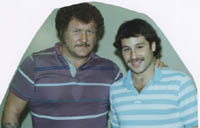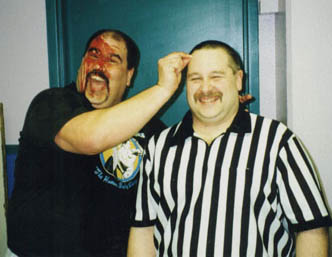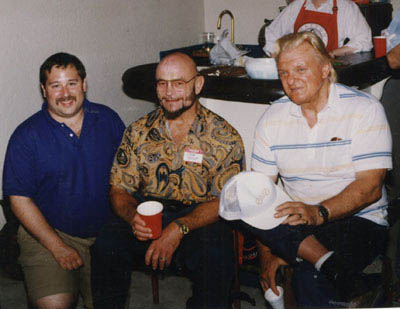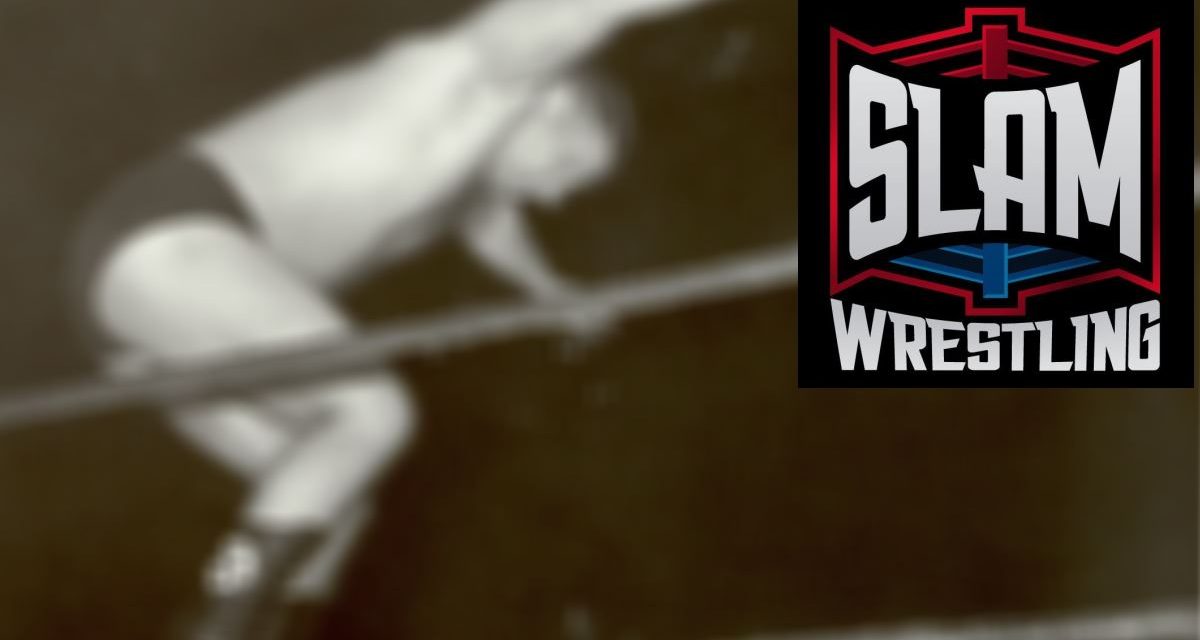The recent passing of wrestler Johnny Kostas is yet another in a long string of wrestling deaths. Anyone wishing to remember Kostas’ career might turn to the Internet, but would be sorely disappointed. There is very little information on Kostas available online and what little there is requires some serious and time-consuming navigation.
Subscribers to Ring Around the Northwest — a monthly wrestling newsletter circulated in wrestling’s Pacific Northwest territory — are, however, provided with a detailed bio of Kostas and a moving reflection of his career that began nearly sixty years ago.

Mike Rodgers, publisher of Ring Around The Northwest (right) with Harley Race way back when. All photos courtesy Mike Rodgers
Wrestling fans love the Internet, but when it comes to collecting valuable and timely information, Mike Rodgers, the creator of Ring Around the Northwest (RATNW), has proven it is not yet king.
“The Internet has opened up communication — there is a lot of information out there,” Rodgers conceded in an interview with SLAM! Wrestling. “But the Internet doesn’t have all the information. The Internet is mostly the fans commenting, or the promotions providing card news and information. On a local level, there isn’t a lot of analysis or wrestler input because wrestler interaction with the fans on message boards is still minimal.”
Some promoters believe the Internet has had a negative impact on independent wrestling — some have even gone so far as to say it has ruined the entire scene. But people turn to the ‘Net for everything from making bill payments to ordering pizza, so it is only natural they would log on for wrestling information.
Rodgers said that while there is a lot of information available online, writing a newsletter that is distributed through snail mail or physically sold at wrestling shows still gives him an advantage.
“I think there is still information that you will find in RATNW that you won’t find in other places,” he said. “I would be willing to say usually every single person that reads it, wrestlers included, will learn at least one thing, or find something that is of interest.”
The July 2005 issue is a good example. Besides providing updated information and results from at least ten different independent Pacific Northwest wrestling promotions, this issue of RATNW contains information on wrestler Sonny O’Mara’s retirement, an update on the fate of the now-defunct Washington State Wrestling, a very in-depth profile of Pacific Cup Champion Aaron Idol and, of course, the Johnny Kostas tribute.
Rodgers has written the RATNW bulletin for 23 years, which is a big investment both in terms of time and money. But he does it because of his love of wrestling, a sport he was first introduced to as a six-year old.
“The very first time I saw wrestling I was absolutely mesmerized,” he recalled. “It was probably 1965 or 1966 and I was only 5 or 6 years old. I think what I was seeing was from Hawaii, but I can’t be absolutely sure. My mom would send me to bed, but I would stand up and peek over the dresser to try and watch it.”
His grandfather took him to see his first wrestling show where he saw wrestlers like Stan Stasiak, Sandy Barr, Tony Borne, Bad Boy Shields, Frenchy Robbierre, Soldat Gorky and Luigi Macera. A few years later, young Rodgers moved to Ohio, but his fascination with wrestling remained.
“I made my grandma save a year’s worth of papers so when I came back in the summer I could cut out all the wrestling articles. One of the differences with me was I didn’t just want to know what was happening right now, I wanted to know what happened before — before I started watching it, before I was born, etc. Eventually I did that research and have just about the complete history of wrestling in the Northwest.”
As he grew older, Rodgers contemplated a career as a wrestler, but was soon distracted. In 1980, a friend of his named Ken Hamblin started putting out a bulletin called Ring Around the World. Rodgers helped Hamblin with the bulletin and then decided to start his own called Ring Around the Northwest that would specifically chronicle wrestling happenings in the Pacific Northwest. It launched in May of 1983.
“After a few years, the bulletin started opening doors for me,” Rodgers remembered. He met Ed Moretti in 1987 who taught Rodgers more about the wrestling business and even asked him to ref some shows in South Oregon.

A bloody “Moondog” Ed Moretti hangs with ref Rodgers.
“I reffed for about three years and I enjoyed it very much, but I also missed being a fan at the same time and just sitting and watching the shows,” Rodgers said. His final match as a ref pit Greg Valentine against The Grappler (Len Denton). Rodgers remembers the final moments.
“Valentine flails Grappler off and he lands on me. Valentine then goes to drop an elbow on Grappler who is going to move and Valentine hits me with the elbow for a big finish. So we set it up, now I know this elbow is going to be stiff because it is Greg Valentine.
“He hits it and I have a buddy sitting about 10 rows back. He later tells me that I sat up and made the best face he has ever seen. He is laughing like crazy and he asks me if I was selling. I told him I wasn’t selling anything. I felt like that elbow was going right through me!”
The transition from wrestling fan to wrestling journalist wasn’t an easy one. When in the dressing room, Rodgers would sit quietly in the corner and soak everything in. But as time went by, he became accepted by the wrestlers and the transition was complete.
“I remember one time I was sitting by Richie Magnett watching a match on a monitor,” Rodgers remembered. “Richie is also pretty quiet. When the match on TV was over, Richie reaches over, doesn’t say a word, and just chops me. That made me feel good, like I was becoming one of the boys.”
In the early days of the publication, Rodgers would interview the wrestlers by mail — he would send out the questions and they would write back the answers. Some sent cassette tapes with their answers recorded on them. He has also conducted some pretty important interviews via telephone.
“I am always a little excited and apprehensive when I start to talk to a Lou Thesz or a Don Leo Jonathon or Dory Funk Jr. on the phone. Usually, though, within a few minutes it is a lot more comfortable and everyone has been very gracious.”
Like many in the independent wrestling business, Mike has a lot on his plate. Besides writing RATNW, he has a job as a physical education teacher. He has also been married for 17 years to a woman who hates wrestling and as Mike put it, “got to our 14-year old son first” and turned him away from wrestling.
Nevertheless, Mike continues to balance his family and his work life with his love of wrestling. There have been many sacrifices made — not only of time and energy, but financially as well. RATNW is not exactly what you would call a moneymaking machine. He only charges subscribers $1 an issue — which barely covers the cost of the printing.
“I am sure I lose money each month on RATNW,” he said. “I just hope that fans feel they get their money’s worth. Printing costs just went up this past issue. It now costs 60 cents to print and 37 cents to mail it out. That means I make 3 cents per issue. That probably means I am a bad businessman.” He laughed.
But just because the newsletter is not a resounding financial success does not mean it has not been successful, if the reactions from those who read it are any indication.
“I guess there were times when I would pass out the sheet at the matches to the boys before the matches and almost everyone would break it out and take the time to read it. I know they mainly were just looking to see what I might have written about them, but I think a lot of them were also interested in most of the items in the sheet.”

Mike Rodgers with Ivan Koloff and Johnny Valentine.
This is how Mike came up with the newsletter’s catchphrase, “The Sheet the Boys Read.” “That statement hopefully lends credibility to it,” he said. “If it is good enough for the Boys it should be good enough for the regular fans.”
Mark Markley is one of those fans who has been subscribing to RATNW for approximately 15 years. When asked for his opinion on the publication, his answer is immediate.
“It’s the only local newsletter that I’ve found that keeps me up to date with what’s happening in the Northwest regarding pro wrestling,” he said. “Mike is a very good journalist, in my opinion. He puts a lot of effort in his newsletter and also into collecting old pro wrestling results from all over. The price of his sheet is only $1.00 and has been for a long time. I remember when it was 50 cents. He doesn’t make much money from it — he does it because he loves it.”
While it’s obviously true that Mike loves what he does, that love goes beyond just putting out the monthly newsletter. For him, RATNW is much more than words on a page. It presents with it not only timely information for fans and wrestlers alike to read, but the opportunity to affect events in a positive way. The story of Tito Carreon is just one such example.
“Several years ago Tito Carreon’s house burned down,” Mike explained. “I said for one month’s time, any subscription money for RATNW would go directly to Tito. I was able to present him with $200 ($100 of which came as a direct gift from wrestler Chris Del Sol). I was very proud of that incident.”
RATNW‘s influence goes beyond any one personality or any one wrestling show. Mike said it has also helped some of the younger wrestling talent move up in the industry.
“There has been a few instances where we have interviewed and given some publicity to some of the youngsters which has helped them get booked on different shows,” he said. “I am very proud of that.”

Buddy Wayne, a member of the Old World Order, sings the praises of RATNW in Portland Wrestling.
RATNW has even found its way into the ring as a foreign object. “For the past few months Buddy Wayne has pulled out the latest issue of RATNW and used it in some manner,” Mike told SLAM! “He stuffed it in Scotty Mac’s mouth one time. Last month he pulled out the page of old-timer Roger MacKay and said it was Matt Borne’s high school photo.”
The wrestling world has changed so much in the 23 years in which Rodgers had been writing Ring Around the Northwest. Mike’s publication has changed too and as he sees it, for the better.
“The main difference between the first issue and the latest one is that when I started in was just me, the show that I watched and my thoughts. Three pages on a typewriter. Now it has a little better look to it. Always 10 pages and there are many times that I could come out with more.”
The Internet Age is poised, though, to change the way everything works, including wrestling. In many respects, it already has. So how long can a ten-page newsletter distributed through snail mail and sold at independent wrestling shows expect to survive and how long does Mike see himself continuing to put it out?
“If RATNW were my main source of income,” he said. “I probably would have had to change jobs. But it isn’t, it is a hobby. I enjoy doing it. I enjoy when someone does an excellent interview. Because then I am very excited to get it out there for people to read. I fully expect to be doing RATNW as long as I can. It never gets old or is a burden.”
Ring Around the Northwest is already part of the history and tradition of the Pacific Northwest wrestling scene. Its place is etched in the memories of those both in the dressing room and in the audience. But nothing lasts forever, so Rodgers is asked what he would like his newsletter’s legacy to be.
“I would love for it to be remembered fondly by both fans and wrestlers alike,” he answered after a moment. “I would hope that people remember it as something that was interesting and had a place in the history of Northwest wrestling.”
RELATED LINKS

